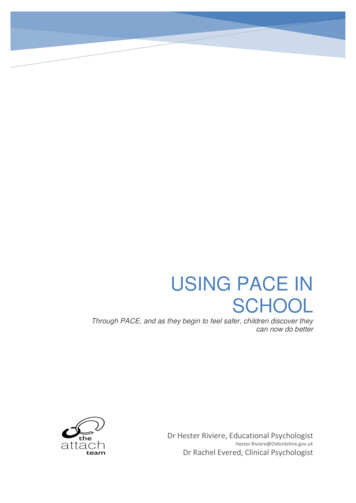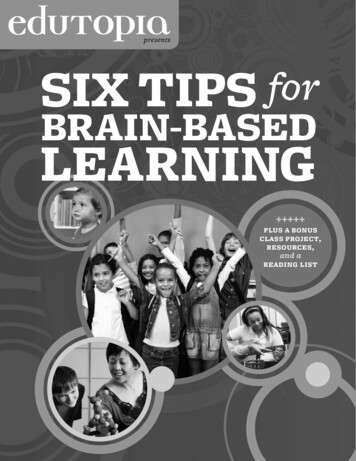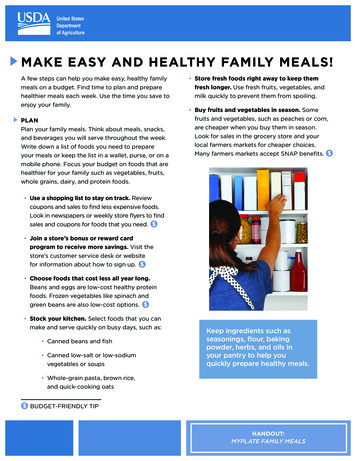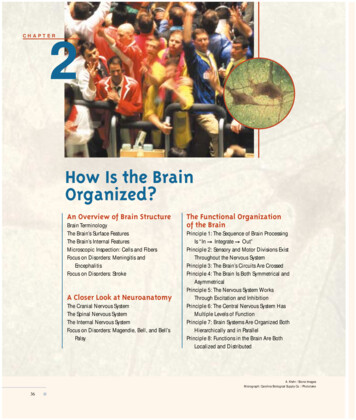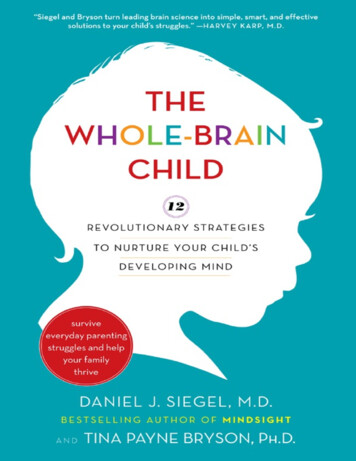
Transcription
All identifying details, including names, have been changed except for those pertaining tothe authors’ family members. This book is not intended as a substitute for advice from atrained professional.Copyright 2011 by Mind Your Brain, Inc., and Bryson Creative Productions, Inc.All rights reserved.Published in the United States by Delacorte Press, an imprint of The Random HousePublishing Group, a division of Random House, Inc., New York.DELACORTE and colophon are registered trademarks of Random House, Inc.LIBRARY OF CONGRESS CATALOGING-IN-PUBLICATION DATASiegel, Daniel J.The whole-brain child : 12 revolutionary strategies to nurture your child’s developingmind / Daniel J. Siegel, Tina Payne Bryson.p. cm.eISBN: 978-0-553-90725-41. Parenting. 2. Child development. 3. Child rearing.I. Bryson, Tina Payne. II. Title.HQ755.8.S53123 2011649’.1019—dc222010052988Illustrations by Tuesday MourningJacket design: Misa Erderv3.1 r2
ContentsCoverTitle PageCopyrightIntroduction: SURVIVE AND THRIVEChapter 1: PARENTING WITH THE BRAIN IN MINDChapter 2: TWO BRAINS ARE BETTER THAN ONE: Integratingthe Left and the RightWhole-Brain Strategy #1: Connect and Redirect: Surfing EmotionalWavesWhole-Brain Strategy #2: Name It to Tame It: Telling Stories to CalmBig EmotionsChapter 3: BUILDING THE STAIRCASE OF THE MIND:Integrating the Upstairs and Downstairs BrainWhole-Brain Strategy #3: Engage, Don’t Enrage: Appealing to theUpstairs BrainWhole-Brain Strategy #4: Use It or Lose It: Exercising the UpstairsBrainWhole-Brain Strategy #5: Move It or Lose It: Moving the Body toAvoid Losing the MindChapter 4: KILL THE BUTTERFLIES! Integrating Memory forGrowth and Healing
Whole-Brain Strategy #6: Use the Remote of the Mind: ReplayingMemoriesWhole-Brain Strategy #7: Remember to Remember: MakingRecollection a Part of Your Family’s Daily LifeChapter 5: THE UNITED STATES OF ME: Integrating the ManyParts of the SelfWhole-Brain Strategy #8: Let the Clouds of Emotion Roll By:Teaching That Feelings Come and GoWhole-Brain Strategy #9: SIFT: Paying Attention to What’s Going OnInsideWhole-Brain Strategy #10: Exercise Mindsight: Getting Back to theHubChapter 6: THE ME-WE CONNECTION: Integrating Self andOtherWhole-Brain Strategy #11: Increase the Family Fun Factor: Making aPoint to Enjoy Each OtherWhole-Brain Strategy #12: Connect Through Conflict: Teach Kids toArgue with a “We” in MindConclusion: BRINGING IT ALL TOGETHERRefrigerator SheetWhole-Brain Ages and StagesDedicationAcknowledgmentsAbout the Authors
INTRODUCTION:Survive and ThriveYou’ve had those days, right? When the sleep deprivation, themuddy cleats, the peanut butter on the new jacket, the homeworkbattles, the Play-Doh in your computer keyboard, and the refrainsof “She started it!” leave you counting the minutes until bedtime.On these days, when you (again?!!) have to pry a raisin from anostril, it seems like the most you can hope for is to survive.However, when it comes to your children, you’re aiming a lothigher than mere survival. Of course you want to get through thosedi cult tantrum-in-the-restaurant moments. But whether you’re aparent or other committed caregiver in a child’s life, your ultimategoal is to raise kids in a way that lets them thrive. You want themto enjoy meaningful relationships, be caring and compassionate, dowell in school, work hard and be responsible, and feel good aboutwho they are.Survive. Thrive.We’ve met with thousands of parents over the years. When weask them what matters most to them, versions of these two goalsalmost always top the list. They want to survive di cult parentingmoments, and they want their kids and their family to thrive. Asparents ourselves, we share these same goals for our own families.In our nobler, calmer, saner moments, we care about nurturing ourkids’ minds, increasing their sense of wonder, and helping themreach their potential in all aspects of life. But in the more frantic,stressful, -to-thesoccer-game moments, sometimes all we can hope for is to avoidyelling or hearing someone say, “You’re so mean!”
Take a moment and ask yourself: What do you really want foryour children? What qualities do you hope they develop and takeinto their adult lives? Most likely you want them to be happy,independent, and successful. You want them to enjoy ful llingrelationships and live a life full of meaning and purpose. Now thinkabout what percentage of your time you spend intentionallydeveloping these qualities in your children. If you’re like mostparents, you worry that you spend too much time just trying to getthrough the day (and sometimes the next ve minutes) and notenough time creating experiences that help your children thrive,both today and in the future.You might even measure yourself against some sort of perfectparent who never struggles to survive, who seemingly spends everywaking second helping her children thrive. You know, the PTApresident who cooks organic, well-balanced meals while reading toher kids in Latin about the importance of helping others, thenescorts them to the art museum in the hybrid that plays classicalmusic and mists lavender aromatherapy through the airconditioning vents. None of us can match up to this imaginarysuperparent. Especially when we feel like a large percentage of ourdays are spent in full-blown survival mode, where we ndourselves wild-eyed and red-faced at the end of a birthday party,shouting, “If there’s one more argument over that bow and arrow,nobody’s getting any presents!”If any of this sounds familiar, we’ve got great news for you: themoments you are just trying to survive are actually opportunities to helpyour child thrive. At times you may feel that the loving, importantmoments (like having a meaningful conversation about compassionor character) are separate from the parenting challenges (likeghting another homework battle or dealing with anothermeltdown). But they are not separate at all. When your child isdisrespectful and talks back to you, when you are asked to come in
for a meeting with the principal, when you nd crayon scribbles allover your wall: these are survive moments, no question about it.But at the same time, they are opportunities—even gifts—becausea survive moment is also a thrive moment, where the important,meaningful work of parenting takes place.For example, think about a situation you often just try to getthrough. Maybe when your kids are ghting with each other forthe third time within three minutes. (Not too hard to imagine, isit?) Instead of just breaking up the ght and sending the sparringsiblings to di erent rooms, you can use the argument as anopportunity for teaching: about re ective listening and hearinganother person’s point of view; about clearly and respectfullycommunicating your own desires; about compromise, sacri ce,negotiation, and forgiveness. We know: it sounds hard to imaginein the heat of the moment. But when you understand a little bitabout your children’s emotional needs and mental states, you cancreate this kind of positive outcome—even without United Nationspeacekeeping forces.There’s nothing wrong with separating your kids when they’reghting. It’s a good survival technique, and in certain situations itmay be the best solution. But often we can do better than justending the con ict and noise. We can transform the experience intoone that develops not only each child’s brain but also herrelationship skills and her character. Over time, the siblings willeach continue to grow and become more pro cient at handlingcon ict without parental guidance. This will be just one of themany ways you can help them thrive.What’s great about this survive-and-thrive approach is that youdon’t have to try to carve out special time to help your childrenthrive. You can use all of the interactions you share—the stressful,angry ones as well as the miraculous, adorable ones—asopportunities to help them become the responsible, caring, capable
people you want them to be. That’s what this book is about: usingthose everyday moments with your kids to help them reach theirtrue potential. The following pages o er an antidote to parentingand academic approaches that overemphasize achievement andperfection at any cost. We’ll focus instead on ways you can helpyour kids be more themselves, more at ease in the world, lledwith more resilience and strength. How do you do that? Ouranswer is simple: you need to understand some basics about theyoung brain that you are helping to grow and develop. That’s whatThe Whole-Brain Child is all about.HOW TO USE THIS BOOKWhether you’re a parent, grandparent, teacher, therapist, or othersigni cant caregiver in a child’s life, we’ve written this book foryou. We’ll use the word “parent” throughout, but we’re talking toanyone doing the crucial work of raising, supporting, and nurturingkids. Our goal is to teach you how to use your everydayinteractions as opportunities to help you and the children you carefor both survive and thrive. Though much of what you’ll read canbe creatively tailored for teens—in fact, we plan to write a followup that does just that—this book focuses on the years from birth totwelve, centering especially on toddlers, school-age kids, andpreteens.In the following pages we explain the whole-brain perspectiveand give you a variety of strategies to help your children behappier, healthier, and more fully themselves. The rst chapterpresents the concept of parenting with the brain in mind andintroduces the simple and powerful concept at the heart of thewhole-brain approach, integration. Chapter 2 focuses on helping achild’s left brain and right brain work together so the child can be
connected to both his logical and emotional selves. Chapter 3emphasizes the importance of connecting the instinctual“downstairs brain” with the more thoughtful “upstairs brain,”which is responsible for decision making, personal insight,empathy, and morality. Chapter 4 explains how you can help yourchild deal with painful moments from the past by shining the lightof understanding on them, so they can be addressed in a gentle,conscious, and intentional way. Chapter 5 helps you teach yourkids that they have the capacity to pause and re ect on their ownstate of mind. When they can do that, they can make choices thatgive them control over how they feel and how they respond totheir world. Chapter 6 highlights ways you can teach your childrenabout the happiness and ful llment that result from beingconnected to others, while still maintaining a unique identity.A clear understanding of these di erent aspects of the wholebrain approach will allow you to view parenting in a whole newway. As parents, we are wired to try to save our children from anyharm and hurt, but ultimately we can’t. They’ll fall down, they’llget their feelings hurt, and they’ll get scared and sad and angry.Actually, it’s often these di cult experiences that allow them togrow and learn about the world. Rather than trying to shelter ourchildren from life’s inevitable di culties, we can help themintegrate those experiences into their understanding of the worldand learn from them. How our kids make sense of their young livesis not only about what happens to them but also about how theirparents, teachers, and other caregivers respond.With that in mind, one of our primary goals has been to makeThe Whole-Brain Child as helpful as possible by giving you thesespeci c tools to make your parenting easier and your relationshipswith your children more meaningful. That’s one reason roughlyhalf of every chapter is devoted to “What You Can Do” sections,where we provide practical suggestions and examples of how you
can apply the scientific concepts from that chapter.Also, at the end of each chapter you’ll nd two sections designedto help you readily implement your new knowledge. The rst is“Whole-Brain Kids,” written to help you teach your children thebasics of what we’ve covered in that particular chapter. It mightseem strange to talk to young children about the brain. It is brainscience, after all. But we’ve found that even small children—asyoung as four or ve—really can understand some important basicsabout the way the brain works, and in turn understand themselvesand their behavior and feelings in new and more insightful ways.This knowledge can be very powerful for the child, as well as theparent who is trying to teach, to discipline, and to love in waysthat feel good to both of them. We’ve written the “Whole-BrainKids” sections with a school-age audience in mind, but feel free toadapt the information as you read aloud, so that it’sdevelopmentally appropriate for your child.The other section at the end of each chapter is called “IntegratingOurselves.” Whereas most of the book focuses on the inner life ofyour child and the connection between the two of you, here we’llhelp you apply each chapter’s concepts to your own life andrelationships. As children develop, their brains “mirror” theirparent’s brain. In other words, the parent’s own growth anddevelopment, or lack of those, impact the child’s brain. As parentsbecome more aware and emotionally healthy, their children reapthe rewards and move toward health as well. That means thatintegrating and cultivating your own brain is one of the mostloving and generous gifts you can give your children.Another tool we hope you’ll nd helpful is the “Ages and Stages”chart at the end of the book, where we o er a simple summary ofhow the book’s ideas can be implemented according to the age ofyour child. Each chapter of the book is designed to help you put itsideas immediately into practice, with multiple suggestions
appearing throughout to address various ages and stages ofchildhood development. But to make it easier for parents, this nalreference section will categorize the book’s suggestions accordingto age and development. If you’re the mother of a toddler, forexample, you can quickly nd a reminder of what you can do toenhance integration between your child’s left and right brain. Then,as your toddler grows, you can come back to the book at each ageand view a list of the examples and suggestions most relevant toyour child’s new stage.Additionally, just before the “Ages and Stages” section, you’llnd a “Refrigerator Sheet” that very brie y highlights the book’smost important points. You can photocopy this sheet and place iton the refrigerator, so that you and everyone who loves your kids—parents, babysitters, grandparents, and so on—can work togetheron behalf of your children’s overall well-being.As we hope you’ll see, we’re keeping you in mind as we work tomake this book as accessible and easy to read as possible. Asscientists, we’ve emphasized precision and accuracy; as parents,we’ve aimed for practical understanding. And we’ve wrestled withthis tension and carefully considered how best to provide you withthe latest and most important information, while doing it in a waythat’s clear, helpful, and immediately practical. While the book iscertainly scienti cally based, you aren’t going to feel like you’re inscience class or reading an academic paper. Yes, it’s brain science,and we’re absolutely committed to remaining true to what researchand science demonstrate. But we’ll share this information in a waythat welcomes you in, rather than leaving you out in the cold.We’ve both spent our careers taking complicated but vital scienti cknowledge about the brain and boiling it down so that parents canunderstand it and immediately apply it in their interactions withtheir kids on a daily basis. So don’t be scared o by the brain stu .We think you’ll nd it fascinating, and much of the basic
information is actually pretty simple to understand, as well as easyto use. (If you are interested in more of the details of the sciencebehind what we’re presenting in these pages, take a look at Dan’sbooks Mindsight and The Developing Mind, 2nd edition.)Thanks for joining us on this journey toward a fuller knowledgeof how you can truly help your kids be happier, healthier, andmore fully themselves. With an understanding of the brain, you canbe more intentional about what you teach your kids, how yourespond to them, and why. You can then do much more thanmerely survive. By giving your children repeated experiences thatdevelop the whole brain, you will face fewer everyday parentingcrises. But more than that, understanding integration will let youknow your child more deeply, respond more e ectively to di cultsituations, and intentionally build a foundation for a lifetime oflove and happiness. As a result, not only will your child thrive,both now and into adulthood, but you and your whole family willas well.Please visit us at our website and tell us about your whole-brainparenting experiences. We look forward to hearing from you.Dan and Tinawww.WholeBrainChild.com
CHAPTER 1Parenting with the Brain in MindParents are often experts about their children’s bodies. They knowthat a temperature above 98.6 degrees is a fever. They know toclean out a cut so it doesn’t get infected. They know which foodsare most likely to leave their child wired before bedtime.But even the most caring, best-educated parents often lack basicinformation about their child’s brain. Isn’t this surprising?Especially when you consider the central role the brain plays invirtually every aspect of a child’s life that parents care about:discipline, decision making, self-awareness, school, relationships,and so on. In fact, the brain pretty much determines who we areand what we do. And since the brain itself is signi cantly shapedby the experiences we o er as parents, knowing about the way thebrain changes in response to our parenting can help us to nurture astronger, more resilient child.So we want to introduce you to the whole-brain perspective.We’d like to explain some fundamental concepts about the brainand help you apply your new knowledge in ways that will makeparenting easier and more meaningful. We’re not saying thatraising a whole-brain child will get rid of all the frustrations thatcome with parenting. But by understanding a few simple and easy-tomaster basics about how the brain works, you’ll be able to betterunderstand your child, respond more e ectively to di cult situations,and build a foundation for social, emotional, and mental health. Whatyou do as a parent matters, and we’ll provide you withstraightforward, scienti cally based ideas that will help you build astrong relationship with your child that can help shape his brain
well and give him the best foundation for a healthy and happy life.Let us tell you a story that illustrates how useful this informationcan be for parents.EEA WOO WOOOne day Marianna received a call at work telling her that her twoyear-old son, Marco, had been in a car accident with his babysitter.Marco was ne, but the babysitter, who was driving, had beentaken to the hospital in an ambulance.Marianna, a principal at an elementary school, frantically rushedto the scene of the accident, where she was told that the babysitterhad experienced an epileptic seizure while driving. Marianna founda re ghter unsuccessfully attempting to console her toddler. Shetook Marco in her arms, and he immediately began to calm downas she comforted him.As soon as he stopped crying, Marco began telling Mariannawhat had happened. Using his two-year-old language, which onlyhis parents and babysitter would be able to understand, Marcocontinually repeated the phrase “Eea woo woo.” “Eea” is his wordfor “Sophia,” the name of his beloved babysitter, and “woo woo”refers to his version of the siren on a re truck (or in this case, anambulance). By repeatedly telling his mother “Eea woo woo,”Marco was focusing on the detail of the story that mattered most tohim: Sophia had been taken away from him.In a situation like this, many of us would be tempted to assureMarco that Sophia would be ne, then immediately focus onsomething else to get the child’s mind o the situation: “Let’s goget some ice cream!” In the days that followed, many parentswould try to avoid upsetting their child by not discussing theaccident. The problem with the “let’s go get some ice cream”
approach is that it leaves the child confused about what happenedand why. He is still full of big and scary emotions, but he isn’tallowed (or helped) to deal with them in an effective way.Marianna didn’t make that mistake. She had taken Tina’s classeson parenting and the brain, and she immediately put what sheknew to good use. That night and over the next week, whenMarco’s mind continually brought him back to the car crash,Marianna helped him retell the story over and over again. She’dsay, “Yes, you and Sophia were in an accident, weren’t you?” Atthis point, Marco would stretch out his arms and shake them,imitating Sophia’s seizure. Marianna would continue, “Yes, Sophiahad a seizure and started shaking, and the car crashed, didn’t it?”Marco’s next statement was, of course, the familiar “Eea woowoo,” to which Marianna would respond, “That’s right. The woowoo came and took Sophia to the doctor. And now she’s all better.Remember when we went to see her yesterday? She’s doing justfine, isn’t she?”In allowing Marco to repeatedly retell the story, Marianna washelping him understand what had happened so he could begin todeal with it emotionally. Since she knew the importance of helpingher son’s brain process the frightening experience, she helped himtell and retell the events so that he could process his fear and go onwith his daily routines in a healthy and balanced way. Over thenext few days, Marco brought up the accident less and less, until itbecame just another of his life experiences—albeit an importantone.As you read the following pages, you’ll learn speci cs about whyMarianna responded as she did, and why, both practically andneurologically, it was so helpful to her son. You’ll be able to applyyour new knowledge about the brain in numerous ways that makeparenting your own child more manageable and meaningful.The concept at the heart of Marianna’s response, and of this
book, is integration. A clear understanding of integration will giveyou the power to completely transform the way you think aboutparenting your kids. It can help you enjoy them more and betterprepare them to live emotionally rich and rewarding lives.WHAT IS INTEGRATION AND WHY DOES IT MATTER?Most of us don’t think about the fact that our brain has manydi erent parts with di erent jobs. For example, you have a leftside of the brain that helps you think logically and organizethoughts into sentences, and a right side that helps you experienceemotions and read nonverbal cues. You also have a “reptile brain”that allows you to act instinctually and make split-second survivaldecisions, and a “mammal brain” that leads you toward connectionand relationships. One part of your brain is devoted to dealing withmemory; another to making moral and ethical decisions. It’s almostas if your brain has multiple personalities—some rational, someirrational; some re ective, some reactive. No wonder we can seemlike different people at different times!The key to thriving is to help these parts work well together—tointegrate them. Integration takes the distinct parts of your brainand helps them work together as a whole. It’s similar to whathappens in the body, which has di erent organs to performdi erent jobs: the lungs breathe air, the heart pumps blood, thestomach digests food. For the body to be healthy, these organs allneed to be integrated. In other words, they each need to do theirindividual job while also working together as a whole. Integrationis simply that: linking di erent elements together to make a wellfunctioning whole. Just as with the healthy functioning of thebody, your brain can’t perform at its best unless its di erent partswork together in a coordinated and balanced way. That’s what
integration does: it coordinates and balances the separate regionsof the brain that it links together. It’s easy to see when our kidsaren’t integrated—they become overwhelmed by their emotions,confused and chaotic. They can’t respond calmly and capably to thesituation at hand. Tantrums, meltdowns, aggression, and most ofthe other challenging experiences of parenting—and life—are aresult of a loss of integration, also known as dis-integration.We want to help our children become better integrated so theycan use their whole brain in a coordinated way. For example, wewant them to be horizontally integrated, so that their left-brain logiccan work well with their right-brain emotion. We also want themto be vertically integrated, so that the physically higher parts of theirbrain, which let them thoughtfully consider their actions, workwell with the lower parts, which are more concerned with instinct,gut reactions, and survival.The way integration actually takes place is fascinating, and it’ssomething that most people aren’t aware of. In recent years,scientists have developed brain-scanning technology that allowsresearchers to study the brain in ways that were never beforepossible. This new technology has con rmed much of what wepreviously believed about the brain. However, one of the surprisesthat has shaken the very foundations of neuroscience is thediscovery that the brain is actually “plastic,” or moldable. Thismeans that the brain physically changes throughout the course ofour lives, not just in childhood, as we had previously assumed.What molds our brain? Experience. Even into old age, ourexperiences actually change the physical structure of the brain.When we undergo an experience, our brain cells—called neurons—become active, or “ re.” The brain has one hundred billionneurons, each with an average of ten thousand connections to otherneurons. The ways in which particular circuits in the brain areactivated determines the nature of our mental activity, ranging
from perceiving sights or sounds to more abstract thought andreasoning. When neurons re together, they grow new connectionsbetween them. Over time, the connections that result from ringlead to “rewiring” in the brain. This is incredibly exciting news. Itmeans that we aren’t held captive for the rest of our lives by theway our brain works at this moment—we can actually rewire it sothat we can be healthier and happier. This is true not only forchildren and adolescents, but also for each of us across the lifespan.Right now, your child’s brain is constantly being wired andrewired, and the experiences you provide will go a long waytoward determining the structure of her brain. No pressure, right?Don’t worry, though. Nature has provided that the basicarchitecture of the brain will develop well given proper food,sleep, and stimulation. Genes, of course, play a large role in howpeople turn out, especially in terms of temperament. But ndingsfrom various areas in developmental psychology suggest thateverything that happens to us—the music we hear, the people welove, the books we read, the kind of discipline we receive, theemotions we feel—profoundly a ects the way our brain develops.In other words, on top of our basic brain architecture and ourinborn temperament, parents have much they can do to provide thekinds of experiences that will help develop a resilient, wellintegrated brain. This book will show you how to use everydayexperiences to help your child’s brain become more and moreintegrated.For example, children whose parents talk with them about theirexperiences tend to have better access to the memories of thoseexperiences. Parents who speak with their children about theirfeelings have children who develop emotional intelligence and canunderstand their own and other people’s feelings more fully. Shychildren whose parents nurture a sense of courage by o ering
supportive explorations of the world tend to lose their behavioralinhibition, while those who are excessively protected orinsensitively thrust into anxiety-provoking experiences withoutsupport tend to maintain their shyness.There is a whole eld of the science of child development andattachment backing up this view—and the new ndings in the eldof neuroplasticity support the perspective that parents can directlyshape the unfolding growth of their child’s brain according to whatexperiences they o er. For example, hours of screen time—playingvideo games, watching television, texting—will wire the brain incertain ways. Educational activities, sports, and music will wire itin other ways. Spending time with family and friends and learningabout relationships, especially with face-to-face interactions, willwire it in yet other ways. Everything that happens to us a ects theway the brain develops.This wire-and-rewire process is what integration is all about:giving our children experiences to create connections betweendi erent parts of the brain. When these parts collaborate, theycreate and reinforce the integrative bers that link di erent partsof the brain. As a result, they are connected in more powerful waysand can work together even more harmoniously. Just as individualsingers in a choir can weave their distinct voices into a harmonythat would be impossible for any one person to create, anintegrated brain is capable of doing much more than its individualparts could accomplish alone.That’s what we want to do for each of our kids: help their brainbecome more integrated so they can use their mental resources tofull capacity. This is exactly what Marianna did for Marco. Whenshe helped him retell the story over and over again (“Eea woowoo”), she defused the scary and traumatic emotions in his rightbrain so that they didn’t rule him. She did so by bringing in factualdetails and logic from his left brain—which, at two years old, is
just beginning to develop—so that he could deal with the accidentin a way that made sense to him.If his mother hadn’t helped him tell and understand the story,Marco’s fears would have been left unresolved and could havesurfaced in
Whole-Brain Strategy #6: Use the Remote of the Mind: Replaying Memories Whole-Brain Strategy #7: Remember to Remember: Making Recollection a Part of Your Family’s Daily Life Chapter 5: THE UNITED STATES OF ME: Integrating the Many Parts of the Self Whole-Brain Strategy #8: Let the Clou


